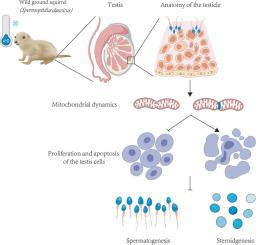Comparative Biochemistry and Physiology A: Molecular & Integrative Physiology ( IF 2.1 ) Pub Date : 2024-01-18 , DOI: 10.1016/j.cbpa.2024.111585 Shiman Guo 1 , Wenjin Yang 1 , Di Chen 1 , Baolong Ren 1 , Li Guo 1 , Xi Wang 1 , Wenqian Xie 1 , Sijie Fan 1 , Maria Daniela Artigas Ramirez 1 , Yingying Han 1 , Zhengrong Yuan 1 , Haolin Zhang 1 , Qiang Weng 1

|
Seasonal reproduction is a widely used breeding strategy in wildlife, especially vertebrates inhabiting temperate regions. Generally, ambient temperature is considered a significant factor influencing the reproductive status of animals. In the present study, wild ground squirrels (Spermophilus dauricus), typical seasonal breeders, were used as an animal model to investigate the mechanism behind the impact of low ambient temperature on testicular function. To simulate the winter environment of wild ground squirrels, we lowered the temperature gradient in the rearing environment to 4 °C. At sampling, the body surface temperature of the squirrels reared under normal ambient temperature (22 °C, NAT group) and the low ambient temperature (4 °C, LAT group) were 31.5 °C and 22.8 °C, respectively. Subsequently, we conducted immunohistochemical assays, qPCR, and enzyme-linked immunosorbent assays (ELISA) to examine the variations in testicular functions, as well as the dynamics and functions of mitochondria, in the squirrels of NAT and LAT groups. As a result, the levels of positive immunostaining for PCNA, P21, and P27 were significantly lower in the testes of LAT group, while the levels of immunostaining for Cleaved Caspase-3 and TUNEL were significantly higher. In addition, the low-temperature treatment reduced the expression level of steroidogenesis-related genes, including LHR, FSHR, GATA-4, P450scc, and P450arom, and decreased the testosterone concentration. Moreover, markers of mitochondrial fission and fusion, DRP1 and MFN2, respectively, were increased in the testes of LAT group. Additionally, the mRNA level of SOD1 was notably higher in the testes of LAT group. In conclusion, the low ambient temperature inhibited spermatogenesis, steroidogenesis, as well as mitochondrial dynamics and functions in the testes of wild ground squirrels.
中文翻译:

低环境温度对野生地松鼠(Spermophilus dauricus)睾丸类固醇生成和线粒体功能的影响
季节性繁殖是野生动物,特别是居住在温带地区的脊椎动物中广泛使用的繁殖策略。一般来说,环境温度被认为是影响动物繁殖状况的重要因素。本研究以典型的季节性繁殖者野生地松鼠( Spermophilus dauricus )为动物模型,研究低环境温度对睾丸功能影响的机制。为了模拟野生地松鼠的冬季环境,我们将饲养环境的温度梯度降低至4℃。采样时,正常环境温度(22℃,NAT组)和低环境温度(4℃,LAT组)饲养的松鼠体表温度分别为31.5℃和22.8℃。随后,我们进行了免疫组织化学测定、qPCR 和酶联免疫吸附测定 (ELISA),以检查 NAT 和 LAT 组松鼠睾丸功能以及线粒体动态和功能的变化。结果,LAT组睾丸中PCNA、P21和P27的免疫染色阳性水平显着降低,而Cleaved Caspase-3和TUNEL的免疫染色阳性水平显着升高。此外,低温处理降低了类固醇生成相关基因的表达水平,包括LHR、FSHR、GATA-4、P450scc和P450arom,并降低了睾酮浓度。此外,LAT组睾丸中线粒体分裂和融合标记物DRP1和MFN2分别升高。此外,LAT组睾丸中SOD1 mRNA水平显着升高。 总之,低环境温度抑制了野生地松鼠睾丸的精子发生、类固醇生成以及线粒体动力学和功能。

































 京公网安备 11010802027423号
京公网安备 11010802027423号